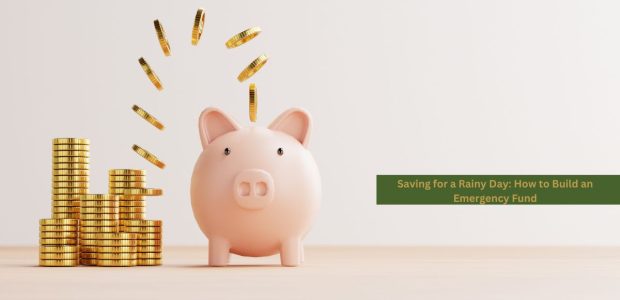It’s time to “Spring into Savings!” As you dust your baseboards, take a moment to dust off your savings goals as well. Whether you haven’t started yet, or you’re not as far along as you’d hoped, this article will discuss emergency funds and other types of savings accounts. Learn to identify the barriers that may be preventing you from saving more and how to overcome them. Choose the right savings account for your emergency fund and take the first small step towards building or growing your emergency fund.

What is an emergency fund?
While there are a variety of savings accounts available that can be used for different purposes, an emergency fund is specifically set aside for unforeseen expenses such as medical emergencies, sudden job loss, or urgent home repairs. In addition to an emergency fund, you may want to keep other savings accounts for specific goals such as vacation, holiday expenses, a wedding or home down payment, or retirement.
Since you may need to tap your emergency fund at any time, it’s best to keep it in a liquid savings account or Money Market. These types of deposit accounts are also FDIC-insured, making them a safe place to keep your money.
Other types of savings accounts, such as CDs and retirement accounts, can be a great way to grow funds for other types of goals, but restrictions on withdrawals do apply.
Examples of when to use your emergency fund
You can set your own rules for when it’s okay (or not) to use your emergency fund. Here are some real-life scenarios of when an emergency fund is essential.
- Medical Emergencies: Unexpected medical expenses, such as emergency surgery or treatments not covered by insurance, can be financially crippling without an emergency fund.
- Job Loss: In the event of sudden unemployment, an emergency fund can provide financial stability, helping you cover living expenses while searching for a new job.
- Urgent Home Repairs: Critical and unforeseen home-related expenses, like fixing a broken heating system in winter, can be managed without incurring debt if you have an emergency fund.
- Car repairs: Essential vehicle repairs, necessary for commuting to work or other daily activities, can be a significant unexpected expense.
- Natural disasters: In the aftermath of natural disasters (floods, hurricanes, earthquakes), immediate access to funds can be vital for temporary accommodations or basic needs while waiting for insurance claims to process.

How Much Emergency Fund Should I Have?
If you currently have no emergency savings, the most important thing is to get started. A general rule of thumb is to keep 3-6 months of living expenses on hand. However, depending on the type of work you do, your family size, and lifestyle, you may want to save less or more than that. Consider the following:
- Are you self-employed or do you work for an employer?
- Do you work in a fairly stable industry, such as healthcare or education? Or a more volatile one, such as tech or media, that may be more prone to layoffs?
- Is there a second earner in your household or are you the sole breadwinner for yourself or your family?
- What are your total essential monthly expenses? (Things like your rent or mortgage, groceries, utilities, etc.)
- Do you have kids and/or pets to support?
Ultimately, only you can decide how much emergency savings you need. If you’re just getting started, you may want to set a more modest initial goal, such as $500 or $1,000. Once you reach that, you can raise the bar.

Psychological Aspects of Saving
Money management may be about math, but it’s also about human psychology. Some people are naturally drawn to saving money because it makes them feel more secure. But others never have enough saved, despite their best intentions. Understanding your own psychological barriers to saving can help you overcome them to reach your goals.
The most common psychological barriers to saving include:
- Instant gratification: Social media and online shopping make it easy to see something you “just have to have” and buy it immediately.
- Underestimating future needs: Humans tend to be optimistic about their futures, underestimating how much money they may need for things like home repairs, healthcare, and other expenses.
- Negative beliefs: You may have inherited this mindset from your parents or developed it from your own history of money struggles. However, believing that “it’s futile” to save or other negative ideas will only keep you stuck where you are.
- Unconscious spending habits: Some things are so routine, we don’t even notice them. Tracking your spending with a budget can help you consciously choose what you want to spend on and what you don’t.
- Keeping Up With The Joneses: Again, we’re not just comparing ourselves to our neighbors anymore, but to anyone and everyone on the Internet. This can lead to feelings of inadequacy or insecurity, driving you to spend money on things you may not even want or need, but think you should.
Once you’ve identified your own personal barriers, these are some strategies that can help you push past mental blocks and develop a savings mindset.
- Celebrate small wins to stay motivated.
- Create a vision board or other way of reviewing your goals to remind yourself why you save.
- Give yourself a grace period, such as 24 hours, after you see something you want to purchase. Do you still want it after the grace period?
- Set up recurring automatic transfers between your checking and savings accounts. You can choose the frequency, such as once a month or every other week. When you “set it and forget it,” your savings will grow without you even having to remember to save.

Choosing the Right Place to Keep Your Emergency Fund
Ready to get started building your emergency fund? If you don’t already have a designated savings account, understand your options and choose the right account for you.
- Kasasa Saver: Earn a higher-than-average interest rate on your emergency fund. Link Kasasa Saver to your Kasasa Checking account for automatic transfer of cash or cash back rewards.
- Personal Savings: A basic savings account to help you get started with your emergency fund.
- Money Market: Once you’ve built a certain minimum balance in your savings account, you can earn more interest with a Money Market account while enjoying certain additional privileges such as check writing.
- CDs: A Certificate of Deposit account requires a certain term commitment (or a penalty for early withdrawals), so we don’t recommend putting your entire emergency fund into a CD. However, a CD can be a good option for growing a portion of your savings with a guaranteed interest rate.
All of these savings account options are FDIC-insured, making them a safe place to store your savings.
About Flanagan State Bank
Founded in 1913, we are a family-owned community bank serving Flanagan, El Paso, Benson, Bloomington, Le Roy, Gridley, and Pontiac, IL. When you bank with us, you become a part of our family. We have been in business for more than 100 years and have continued to grow as we transform banking customers into family members. Together, we are “One Family, Helping Another.” To open a new savings account for your emergency fund, contact us or visit your nearest location.






